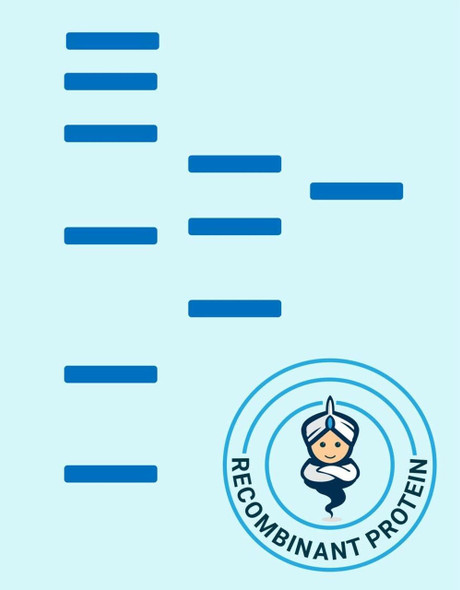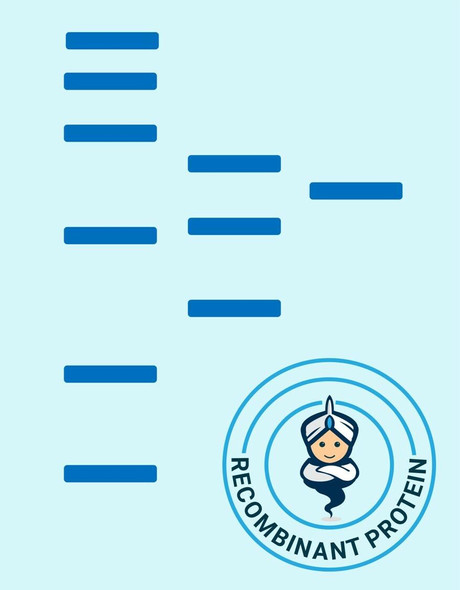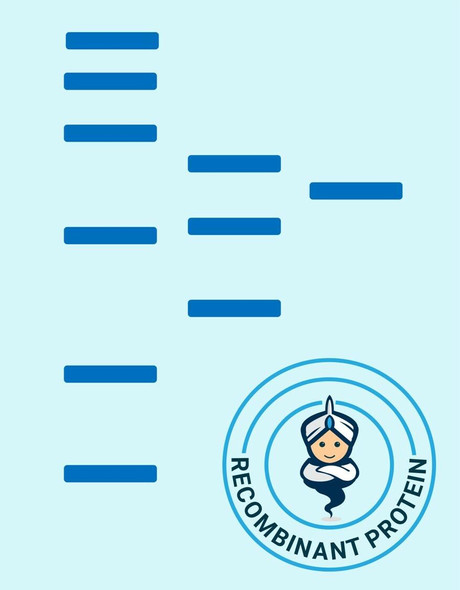Description
| Product Name: | Human FADD Recombinant Protein |
| Product Code: | RPPB3506 |
| Size: | 10µg |
| Species: | Human |
| Target: | FADD |
| Synonyms: | GIG3, MORT1, MGC8528, FADD, Fas (TNFRSF6)-associated via death domain, Protein FADD, FAS-associated death domain protein, FAS-associating death domain-containing protein, Mediator of receptor induced toxicity, Growth-inhibiting gene 3 protein. |
| Source: | Escherichia Coli |
| Physical Appearance: | Sterile filtered colorless solution. |
| Formulation: | The FADD protein solution contains 20mM Tris-HCl, pH-8, and 10% glycerol. |
| Stability: | Store at 4°C if entire vial will be used within 2-4 weeks. Store, frozen at -20°C for longer periods of time.For long term storage it is recommended to add a carrier protein (0.1% HSA or BSA).Avoid multiple freeze-thaw cycles. |
| Purity: | Greater than 95.0% as determined by SDS-PAGE. |
| Amino Acid Sequence: | MRGSHHHHHHGMASMTGGQQ MGRDLYDDDD KDRWGSMDPF LVLLHSVSSS LSSSELTELK FLCLGRVGKR KLERVQSGLD LFSMLLEQND LEPGHTELLR ELLASLRRHD LLRRVDDFEA GAAAGAAPGE EDLCAAFNVI CDNVGKDWRR LARQLKVSDT KIDSIEDRYP RNLTERVRES LRIWKNTEKE NATVAHLVGA LRSCQMNLVA DLVQEVQQAR DLQNRSGAMS PMSWNSDAST SEAS |
FADD is an adaptor protein that cooperates with a variety of cell surface receptors and mediates cell apoptotic signals. Using its C-terminal death domain, FADD is recruited by TNFRSF6/Fas-receptor, tumor necrosis factor receptor, TNFRSF25, and TNFSF10/TRAIL-receptor, and consequently it take parts in the death signaling initiated by these receptors. FADD interaction with the receptors reviels the N-terminal effector domain of, which allows it to recruit caspase-8, and thus initiate the cysteine protease cascade. Knockout studies in mice furthermore propose the significance of FADD in premature T cell development. FADD plays a role in survival/proliferation and cell cycle development. FADD also takes part in cellular sublocalization, protein phosphorylation, and inhibitory molecules.
FADD produced in E.Coli is a single, non-glycosylated polypeptide chain containing 244 amino acids (1-208 a.a.) and having a molecular mass of 27.4 kDa.FADD is fused to 36 amino acid His-Tag at N-terminus and purified by proprietary chromatographic techniques.
| UniProt Protein Function: | FADD: an adaptor molecule that mediates apoptosis. Recruited through its C-terminal death domain by Fas-receptor, tumor necrosis factor receptor, TNFRSF25, and TRAIL-receptor, participating in the death signaling initiated by these receptors. Interaction with the receptors unmasks the N-terminal effector domain of this protein, which recruits caspase-8, and thereby activates the cysteine protease cascade. Knockout studies in mice also suggest the importance of this protein in early T cell development. |
| UniProt Protein Details: | Protein type:Apoptosis; Adaptor/scaffold Chromosomal Location of Human Ortholog: 11q13.3 Cellular Component: neuron projection; CD95 death-inducing signaling complex; cytosol; lipid raft Molecular Function:identical protein binding; protein binding; protease binding; death receptor binding; protein complex binding; tumor necrosis factor receptor superfamily binding; tumor necrosis factor receptor binding Biological Process: viral reproduction; positive regulation of apoptosis; apoptosis; positive regulation of T cell mediated cytotoxicity; positive regulation of proteolysis; protein heterooligomerization; T cell differentiation in the thymus; toll-like receptor 3 signaling pathway; positive regulation of activated T cell proliferation; positive regulation of interleukin-8 production; T cell homeostasis; positive regulation of macrophage differentiation; toll-like receptor 4 signaling pathway; defense response to virus; positive regulation of adaptive immune response; spleen development; caspase activation; positive regulation of I-kappaB kinase/NF-kappaB cascade; thymus development; MyD88-independent toll-like receptor signaling pathway; positive regulation of tumor necrosis factor production; lymph node development; positive regulation of interferon-gamma production; induction of apoptosis via death domain receptors; toll-like receptor signaling pathway; innate immune response; positive regulation of transcription from RNA polymerase II promoter Disease: Infections, Recurrent, With Encephalopathy, Hepatic Dysfunction, And Cardiovascular Malformations |
| NCBI Summary: | The protein encoded by this gene is an adaptor molecule that interacts with various cell surface receptors and mediates cell apoptotic signals. Through its C-terminal death domain, this protein can be recruited by TNFRSF6/Fas-receptor, tumor necrosis factor receptor, TNFRSF25, and TNFSF10/TRAIL-receptor, and thus it participates in the death signaling initiated by these receptors. Interaction of this protein with the receptors unmasks the N-terminal effector domain of this protein, which allows it to recruit caspase-8, and thereby activate the cysteine protease cascade. Knockout studies in mice also suggest the importance of this protein in early T cell development. [provided by RefSeq, Jul 2008] |
| UniProt Code: | Q13158 |
| NCBI GenInfo Identifier: | 2498355 |
| NCBI Gene ID: | 8772 |
| NCBI Accession: | Q13158.1 |
| UniProt Secondary Accession: | Q13158,Q14866, Q6IBR4, |
| UniProt Related Accession: | Q13158 |
| Molecular Weight: | 208 |
| NCBI Full Name: | FAS-associated death domain protein |
| NCBI Synonym Full Names: | Fas (TNFRSF6)-associated via death domain |
| NCBI Official Symbol: | FADD�� |
| NCBI Official Synonym Symbols: | GIG3; MORT1�� |
| NCBI Protein Information: | FAS-associated death domain protein; growth-inhibiting gene 3 protein; mediator of receptor induced toxicity; mediator of receptor-induced toxicity; Fas-associating protein with death domain; Fas-associating death domain-containing protein |
| UniProt Protein Name: | FAS-associated death domain protein |
| UniProt Synonym Protein Names: | FAS-associating death domain-containing protein; Growth-inhibiting gene 3 protein; Mediator of receptor induced toxicity; Protein FADD |
| Protein Family: | Fas-associated death domain protein |
| UniProt Gene Name: | FADD�� |
| UniProt Entry Name: | FADD_HUMAN |






